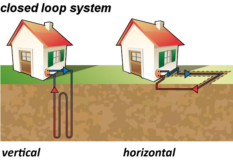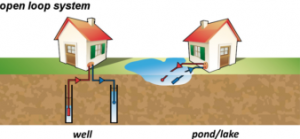Differing from geothermal power plants, geothermal heat pumps or “water-source heat pumps” is an advanced technology that harnesses the nearly constant temperature belowground to heat and cool buildings and establishments. It transfers heat from below into buildings during the colder days and transfers it back below during the warmer days.
There are two geothermal heat pump systems: the closed-loop system and the open-loop system. Each functions differently based on the type of soil, climate conditions, and land available.
Closed-loop System
 Photo from iwae.com
Photo from iwae.com
The closed-loop horizontal system is the most cost-effective geothermal heat pump suitable for residential areas. For larger, commercial buildings, the closed-loop vertical system is more often used.
In a closed-loop system, a water or “antifreeze” mixture circulates through a loop of pipes underground, usually beneath a body of water, and into a building. During the colder days, the temperature belowground is warmer than the air; and so, the fluid pumping in is warmer. Then, the electric compressors and heat exchangers transfer the heath through ducts in the building.
During the warmer days, the pipes draw heat away from the building and is absorbed belowground; and since the fluid is already cool in the summer and warmer than the air in the winter, the heater or air conditioning system does not need to be utilized as much. .
Open-loop System
 Photo from iwae.com
Photo from iwae.com
In this kind of system, the water is taken directly from a water source and into the heat pump where it can either be recycled back into the same source or pumped into another water source — the only difference is the slight change in temperature. However, although this can be cheaper, it also requires a steady flow of water capable of powering homes and establishments.
THE ADVANTAGES AND DISADVANTAGES OF GEOPOWER
It is unmistakably apparent that geothermal energy is one of the best forms of renewable energy in the world.
Apart from the previously mentioned advantages, geothermal energy is the most accessible of all sources of renewable energy. It can be extracted without burning fossil fuels; thus, only producing about a sixth of the carbon dioxide a natural-gas-fueled power plant produces. Binary cycle plants, for instance, does not release any emissions.
However, some also see that it is problematic. The most pressing issue is that it releases hydrogen sulfide — a hazardous gas with a “rotten egg” smell. Another concern is the disposal of geothermal fluids which sometimes contain toxic materials.
With the current state of our climate and environment, renewable energy is the most ideal way to power a country without greatly compromising the environment. Studies even say that utilizing geothermal energy is probably the most ideal way to mitigate climate change; but some still question if it is sustainable.
Yes, geothermal energy is sustainable; however, it is still bound by limitations, particularly in the location of geothermal fields; and when countries result to the transportation of geothermal energy, it may result in energy loss and resource exploitation.
Just because these are “renewable resources” does not mean that these should be drained and exploited. Above all else, responsibility and accountability is needed to sustain and preserve these resources for future generations to use
Sources:
energy.gov
Energy Informative
National Geographic
SaveOnEnergy


